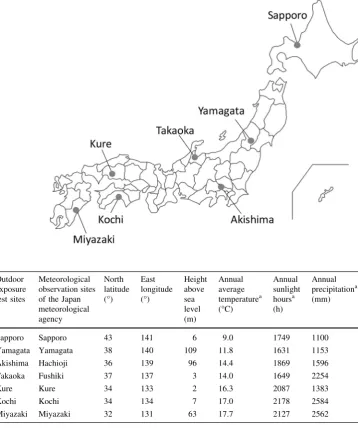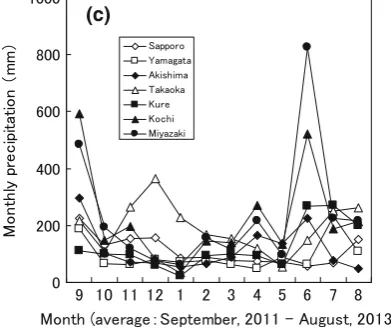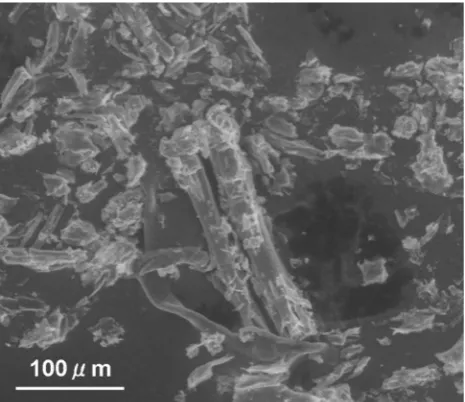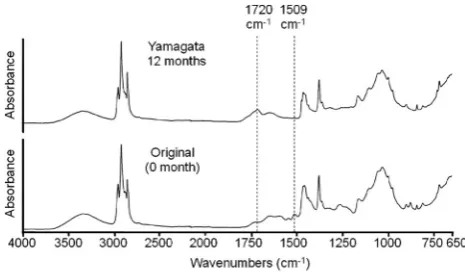O R I G I N A L A R T I C L E
Surface deterioration of wood plastic composites under outdoor
exposure
Kenichi Ebe• Noboru Sekino
Received: 22 July 2014 / Accepted: 7 November 2014 / Published online: 3 December 2014 ÓThe Japan Wood Research Society 2014
Abstract Outdoor exposure tests of wood plastic com-posites (WPCs) were conducted at seven sites in Japan. The tests examined the process of chalking on the surface of the WPCs and the weather factors affecting chalking. Obser-vations using a scanning electron microscope and a polarization optical microscope (POM), analyses of Fourier transform infrared spectroscopy, as well as differential scanning calorimetry showed that the deterioration of both wood and polyolefin elements occurs on the surface of WPCs. The POM observations revealed that surface sanding of WPCs in the manufacturing process promoted more chalking. Furthermore, it became clear that among the weather conditions studied, temperature and global solar radiation had the greatest influence on chalking, as determined from the results of single regression analysis. Keywords WPCs Outdoor exposurePolyethylene carbonyl indexChalking Weather factor
Introduction
Recently, wood plastic composites (WPCs) have attracted considerable attention as materials with the combined characteristics of wood and plastic [1, 2]. WPCs are manufactured as easily as plastic, by extrusion molding. In
addition, because ligneous wastes and recycled plastic can be used as raw materials, WPCs are favored from an environmental perspective [3]. In 2010, the global pro-duction of WPCs was about 1540000 tons per year, with 980 000 tons in the United States, 300000 tons in China, 167000 tons in Europe, and 21000 tons in Japan [4].
As WPCs are primarily used on exteriors, concerns about their water resistance and decay resistance have increased. It is clear that water resistance and decay resistance depend on the proportion of wood in WPCs [5– 7]. Water and decay resistance decline remarkably, espe-cially on the surface of WPCs, when the proportion of wood is more than 50 % [6–8].
Recently, the durability of WPCs has been a topic of growing interest, with several reports on the decrease in strength and surface deterioration [9–11]. A large scale outdoor exposure test is effective for evaluating the influ-ence of weather factors on the durability of wood-based composites [12–14]. However, there have been few examples of such tests using WPCs [15]. Furthermore, little attention has been paid to research on the occurrence of chalking, which is one of the surface deterioration phe-nomena of WPCs [16]. Chalking is a phenomenon through which powders separate from the surface of WPCs. Chalking is seldom a problem when WPCs are used as decking, because it affects only footwear. So some com-mercial products of WPCs improved chalking generation using photo stabilizers or reducing wood content of the surfaces. However, the mechanism of chalking has not been cleared.
This study is aimed at explaining the principal causes of chalking in WPCs. Outdoor exposure tests of WPCs were carried out at seven sites in Japan, and the process of chalking with respect to various weather factors was investigated.
K. EbeN. Sekino
Iwate University, Morioka 020-8550, Japan e-mail: sekino@iwate-u.ac.jp
K. Ebe (&)
Yamagata Research Institute of Technology, Yamagata 990-2473, Japan
Materials and methods
Samples
The raw materials of the WPCs used in this research were building wood waste and recycled plastic (polyolefin). The ratio of wood flours to polyolefin [polyethylene (PE) and polypropylene (PP)] was about 55:45 (w/w). About 5 % of compatibilizers and pigments were added. But any photo stabilizers such as UV absorbers (UVA) or hindered amine light stabilizers (HALS) were not added because of easy generation of chalking. Test specimens used in this study were made by the extrusion method. Sanding was then carried out on the surface of the WPCs to give the appearance of wood. The specimens with a size of 145–174 (longitudinal)970 (width)97 mm (thickness) were
prepared from the 30 mm thick commercial hollow decks. Polyethylene reference samples, PE-RS (Japan weathering test center [17,18]), were prepared to evaluate the oxida-tion–degradation of polyolefin in WPCs. The PE-RS were exposed outdoors at the same sites that were used for the WPCs outdoor exposure tests.
Outdoor exposure tests at seven sites in Japan
The WPCs and PE-RS were subjected to outdoor exposure tests at seven sites in Japan (Fig.1): Sapporo (43°N, 141°E), Yamagata (38°N, 140°E), Akishima (36°N, 139°E), Takaoka (37°N, 137°E), Kure (34°N, 133°E), Kochi (34°N, 134°E), and Miyazaki (32°N, 131°E). The annual average temperature, annual sunlight hours, and annual precipitation are listed in Table1. These data were
Fig. 1 Map of the outdoor exposure test sites in Japan
Table 1 Weather conditions of the seven test sites in Japan
a Data are average values of the
past 30 years (1983–2012)
Outdoor exposure test sites
Meteorological observation sites of the Japan meteorological agency
North latitude (°)
East longitude (°)
Height above sea level (m)
Annual average temperaturea (°C)
Annual sunlight hoursa (h)
Annual precipitationa (mm)
Sapporo Sapporo 43 141 6 9.0 1749 1100
Yamagata Yamagata 38 140 109 11.8 1631 1153
Akishima Hachioji 36 139 96 14.4 1869 1596
Takaoka Fushiki 37 137 3 14.0 1649 2254
Kure Kure 34 133 2 16.3 2087 1383
Kochi Kochi 34 134 7 17.0 2178 2584
obtained from the Japan meteorological agency observa-tion sites cloth to the test sites. The monthly average temperature, monthly sunlight hours, and monthly precip-itation over the two-year test duration are shown in Fig.2. Average temperatures of the snow sites (Sapporo, Ya-magata, and Takaoka) were lower than those of the other
sites. Sunlight hours were greater at lower latitudes, with the exception of Yamagata and Takaoka. Yamagata and Takaoka had fewer sunlight hours compared to Sapporo. Takaoka, Kochi, and Miyazaki had high precipitation levels.
The WPCs and PE-RS were set facing the south. Exposure angles were 45° for Sapporo, Yamagata, Aki-shima, Takaoka, and Kochi, and to latitude—10°for Kure and Miyazaki. The WPCs and PE-RS were placed on a test frame, and the outdoor exposure tests were started on August 24 or 25, 2011, and lasted for 2 years. The WPCs were removed from test rack after 3, 6, 9, 12, and 24 months of exposure. The PE-RS were exchanged for new specimens every month during the exposure period of 2 years.
Evaluation of chalking
WPCs surface abrasion tests were used to evaluate the extent of chalking [19]. Abrasion was conducted manually using a finger wrapped in white cloth. Abrasion was carried out once for each specimen, and the distance moved by the finger was set at 80 mm. The pressure of abrasion was approximately 72 kPa. The white cloth used was measured for color before and after the abrasion tests, using a spec-trophotometer (X-Rite, SP88) that reads L*, a*, and b*
values in the CIE-LAB system. The color differences (DE*ab) were calculated using Eqs. (1)–(4).
DL ¼LnL0 ð1Þ
Da¼ana0 ð2Þ
Db¼bnb0 ð3Þ
DEab¼ fðDLÞ2þ ðDaÞ2þ ðDbÞ2g1=2 ð4Þ
The number of specimen was two in each exposure test site. The measurement points of the WPCs were set at one point for each specimen, and the means were calculated. The resulting DE*abvalues were defined as the extent of chalking [19].
Polyethylene carbonyl index
Fourier transform infrared spectroscopy (FT-IR) spectra of the PE-RS were obtained by measuring the transmittance (THERMO Scientific, Nicolet 6700 FT-IR), which was then converted to absorbance. All the spectra obtained were the averages of 24 scans at 4 cm-1. Absorbance of the 1715 cm-1wave number, which corresponds to a carbonyl functional group, and absorbance of the 2020 cm-1, which corresponds to a methylene functional group, were calcu-lated. The polyethylene carbonyl index (PE-CI) was cal-culated using Eq. (5) and Fig.3 [17,18].
(a)
(b)
(c)
PE-CI ¼ A1715=A2020 ð5Þ
where, A1715 is the absorbance of the nearby 1715 cm
-1
,
A2020 is the absorbance of the nearby 2020 cm-1. Each
absorbance was calculated from Eq. (6).
A¼II0 ð6Þ
where,Iis the absorbance of each wave number,I0is the
absorbance of the base line in each wave number, as shown in Fig.3.
Analysis of the surface deterioration
Scanning electron microscope (SEM)
Scanning electron microscope observations were carried out to evaluate the shape of the chalking products. The surfaces of the WPCs exposed outdoors in Yamagata for 12 months (Yamagata 12 months) were placed in contact with conductive tape. The chalking products, which stuck to the tape, were observed using the low vacuum mode of the SEM without metal evaporation (FEI, Quanta400).
Polarization optical microscope (POM)
Polarization optical microscope observation was carried out to verify the dispersion of wood elements and polyolefin on the surface of the WPCs before and after the outdoor expo-sure. Films with a thickness of 30lm were cut off from the vertical cross-sections of the extrusion direction of the WPCs [Yamagata 12 months and the original (un-exposed speci-men)] using a rotary type microtome. The films were observed using a polarization microscope (Olympus BH2).
Fourier transform infrared spectroscopy analysis
FT-IR-ATR analysis was carried out to investigate the change in the main functional group on the surface of the
WPCs before and after the outdoor exposure. The surface of the Yamagata 12 months and the un-exposed specimens were measured by FT-IR-ATR (PerkinElmer, Frontier Gold FTIR). All the spectra obtained were the averages of 8 scans at 4 cm-1.
Differential scanning calorimetry analysis (DSC)
Differential scanning calorimetry analysis was carried out to obtain information on the deterioration of the polyolefins on the surface of the WPCs before and after the outdoor exposure. Films with a thickness of approximately 50lm were cut off from the surface of the WPCs (Yamagata 12 months and the original) with an ultra-microtome, and measured by DSC (PerkinElmer, DSC8500) under a nitrogen atmosphere. The film specimens were heated to 200 °C at a rate of 10°C/min (1st heating) and kept at that temperature for 3 min. They were then cooled down to 30°C at a rate of 10°C/min and kept at that temperature for 3 min. And they were finally heated up to 200 °C (2nd heating).
Results and discussion
Results of the outdoor exposure test
Chalking
Figure4shows the extent of chalking for the different speci-mens. The data from cold areas (Sapporo, Yamagata, and Takaoka) and warm areas (Akishima, Kure, Kochi and Miyazaki) were plotted as outlined symbols and filled symbols, respectively. The color difference of chalking (DE*ab) con-tinued to increase for up to 1 year of outdoor exposure. After 1 year,DE*abwas saturated. The tendency ofDE*abto change can be compared in the cold areas and the warm areas. Fig. 3 Measurement method for the polyethylene carbonyl index
(PE-CI) [17,18]
Figure5shows the relationship betweenDE*aband var-ious weather factors [(a) sum of daily average temperatures, (b) sum of daily global solar radiation, and (c) sum of daily precipitation] during one year of outdoor exposure. Data from the Japan Meteorological Agency were adopted for each weather condition [20]. Global solar radiation was adopted as a substitute for sunlight hours, as more accurate analytical results can be expected compared to sunlight hours. However, global solar radiation data on Akishima, Takaoka, and Kure did not exist in the database of the Japan
Meteorological Agency. Therefore, the global solar radia-tion for these regions was estimated using the number of sunlight hours and the latitude [21]. Single linear regression analysis was then performed on the data. The coefficients of determination were 0.80, 0.79, and 0.53 for the (a) sum of daily average temperature, (b) sum of daily global solar radiation, and (c) sum of daily precipitation, respectively.
From these results, it was determined that temperature and global solar radiation had the greatest influence on chalking.
Polyethylene carbonyl index
Figure6 shows the relationships between the PE-CI and various weather factors during 2 years of outdoor expo-sure: (a) monthly average temperature, (b) monthly global
(a)
(b)
(c)
Fig. 5 The relationship between chalking (DE*ab) and various weather factors during 1 year of outdoor exposure.a Sum of daily average temperatures,bsum of daily global solar radiation,csum of daily precipitation
(a)
(b)
(c)
solar radiation, and (c) monthly precipitation. A regression curve was applied to the data on PE-CI and the monthly average temperature (Fig.6a) [22], and the coefficient of determination was 0.73. As shown in Fig.6b, the PE-CI increased with an increase in global solar radiation, although the coefficient of determination was much lower (0.45) compared to the monthly average temperature. On the other hand, no correlation was found between PE-CI and monthly precipitation (Fig.6c). From these results, it was found that the temperature had the greatest influence on the oxidative reaction of PE, which suggests that the same effect occurs on polyolefin elements in WPCs. Analytical results of the surface deterioration layer
SEM
Figure7 shows an SEM image of the chalking products of the Yamagata 12 months specimen. Fibrous sub-stances with a length of about 200lm and particulate matter under 50lm in diameter were observed. In a previous study, in which chalking products were mea-sured with IR [16], it was suggested that the chalking products might be composed of wood elements and plastic elements. This SEM image thus showed that both wood elements and plastic elements came from the surface of the WPCs.
POM
Figure8 shows POM images of the surface of the WPCs (Yamagata 12 months and the original). Particles that have a light color are polyolefins. Particles that are dark in color
were assumed to be wood elements or compound areas consisting of wood and polyolefin elements.
The surface of the original specimen already had some roughness. However, surface roughness increased when subjected to outdoor exposure.
FT-IR
Figure9 shows FT-IR spectra of the surface of the WPCs (Yamagata 12 months and the original). The peak near 1720 cm-1 increased a little after 1 year of outdoor exposure. This implies that oxidation of both wood and polyolefin occurred [23]. The peak at 1509 cm-1 almost disappeared after outdoor exposure. This implies that degradation of lignin occurred.
DSC
Figure10 shows DSC 2nd heating curves of the approxi-mately 50lm thick films cut off from the surfaces of the WPCs (Yamagata 12 months and the original). Peaks at Fig. 7 SEM image of the chalking products generated from the
surface of the WPCs (Yamagata 12 months)
nearly 129°C and 163°C correspond to the melting tem-perature of PE and PP, respectively. The peak due to the melting of PE was relatively unchanged by outdoor expo-sure, whereas the peak due to the melting of PP became broader. Furthermore, the peak temperature of PP decreased by 1.6°C. These results suggest that molecular weight of PP decreased.
Factors responsible for the occurrence of chalking Factors responsible for the occurrence of chalking were determined from statistical analyses of chalking and PE-CI by various weather factors, and from results of SEM, POM, FT-IR and DSC. Chemical degradation of lignin begins on the surface of WPCs due to outdoor exposure. As for polyolefins, an oxidative reaction occurs in both PE and PP. However, PP deteriorates more easily than PE, and the molecular weight of PP decreases. The bond strength between polyolefin (especially PP) and the wood elements decreases. It has already been shown that separation pro-ducts are easily formed from the surface of WPCs before outdoor exposure by surface sanding. In addition, the sur-face of WPCs becomes rougher due to outdoor exposure. Therefore, it is believed that chalking occurs due to the
combined effect of the deterioration reaction and the sanding process when an abrasive force is added to the surface.
Temperature and global solar radiation have the greatest influence on the occurrence of chalking. These are likely to be because the oxidation reaction on the surface of WPCs is more susceptible to temperature and chemical degrada-tion of lignin and a decrease of the molecular weight of PP is more susceptible to global solar radiation.
There was almost no difference in the amount of chalking between 1 and 2 years of exposure (Fig. 4). A similar saturation phenomenon was reported in a previous study on the change in oxygen content on the surface of a Japanese lacquer film, as measured by an outdoor exposure test [24]. The oxides were gradually eroded off the surface of the Japanese lacquer film due to wind and rain [24]. Therefore, it is assumed that the same phenomenon may have occurred in the case of the WPCs. Initially, the amount of oxides eroded by the wind and rain in the absence of frictional forces increased after an exposure period of 1 year. Next, deterioration began in the areas where the oxides were eroded by wind and rain, which resulted in new chalking products on the surface. Finally, the amount of chalking measured by frictional examination settled down to a certain fixed value.
Conclusions
Outdoor exposure tests of WPCs were carried out at seven sites in Japan, and chalking on the surface of the WPCs was examined. It was determined that deterioration of wood elements, oxidation of polyolefins, and a decrease in the molecular weight of PP occurred on the surface of the WPCs. Surface sanding of the WPCs also promoted the occurrence of chalking. Furthermore, the results of a single regression analysis indicated that temperature and global solar radiation were the most dominant weather factor influencing chalking. In addition, chalking products can be washed away to a certain extent due to precipitation. Acknowledgments This study was supported by the Council of Promotion for Industrial Technology Collaboration, Nanotechnology and Materials committee, Polymer subcommittee. The authors wish to thank Mr. Akihiro Oishi of National Institute of Advanced Industrial Science and Technology for the measurement of the FT-IR spectra of PE-CI, and Dr. Takashi Kuriyama of Yamagata University for valu-able discussions and his assistance in taking the POM images. We express our gratitude to Dr. Koetsu Takahashi of Yamagata Univer-sity and Dr. Hisayoshi Kofujita of Iwate UniverUniver-sity for their valuable comments. We also thank Mr. Katsumi Konno and Mr. Takashi Oichi of Hokkaido Research Organization Industrial Technology Research Department, Dr. Takeshi Yasuda and Dr. Kenichi Shimizu of Tokyo Metropolitan Industrial Technology Research Institute, Mr. Wataru Mizuno of Toyama Industrial Technology Center, Mr. Kimitaka Tahira of Hiroshima Prefectural Technology Research Institute Fig. 9 FT-IR-ATR spectra of the WPCs
Western Region Industrial Research Center, Dr. Nozomu Tsuruta of Kochi Prefectural Industrial Technology Center, and Mr. Shingo Hamayama of Miyazaki Prefecture Industrial Technology Center, for their cooperation in the outdoor exposure tests.
References
1. Takatani M, Okamoto T (2008) Fundamental and application of cellulose materials: wood plastic composite (in Japanese). J Soc Mater Sci Jpn 57:415–420
2. Rowell RM (2007) Challenges in biomass-thermoplastic com-posites. J Polym Environ 15:229–235
3. Okamoto T (2003) Recent developments in wood/plastic com-posites: extrusion of wood-based materials (in Japanese). Mo-kuzai Gakkaishi 49:401–407
4. Kikuchi T (2012) The market trend of wood plastic composites (in Japanese). Mokuzai Kogyo 67:475–477
5. Pendlton DE, Hoffard TA, Adcock T, Woodward B, Wolcott MP (2002) Durability of an extruded HDPE/wood composite. Forest Prod J 52:21–27
6. Kiguchi M, Kataoka Y, Matsunaga H, Momohara I, Kawamoto S, Ohtomo Y (2010) Durability of woodflour-plastic composites (1) Influence of woodflour content on water resistance (in Japanese). Mokuzai Hozon (Wood preservation) 36:52–58
7. Kiguchi M, Kataoka Y, Matsunaga H, Momohara I, Kawamoto S, Kobayashi M, Ohtomo Y (2010) Durability of woodflour-plastic composites (2) Evaluation of decay resistance by soil-buried test (in Japanese). Mokuzai Hozon (Wood preservation) 36:150–157 8. Wang W, Morrell JJ (2004) Water sorption characteristics of two
wood-plastic composites. Forest Prod J 54:209–212
9. Stark NM (2006) Effect of weathering cycle and manufacturing method on performance of wood flour and high-density poly-ethylene composites. J Appl Polym Sci 100:3131–3140 10. Stark NM, Matuana LM (2006) Influence of photostabilizers on
wood flour-HDPE composites exposed to xenon-arc radiation with and without water spray. Polym Degrad Stab 91:3048–3056 11. Stark NM, Matuana LM (2007) Characterization of weathered wood-plastic composite surfaces using FTIR spectroscopy, con-tact angle, and XPS. Polym Degrad Stab 92:1883–1890 12. Kojima Y, Shimoda T, Suzuki S (2011) Evaluation of the
weathering intensity of wood-based panels under outdoor expo-sure. J Wood Sci 57:408–414
13. Kojima Y, Shimoda T, Suzuki S (2012) Modified method for evaluating weathering intensity using outdoor exposure tests on wood-based panels. J Wood Sci 58:525–531
14. Sekino N, Sato H, Adachi K (2014) Evaluation of particleboard under outdoor exposure using several different types of weath-ering intensity. J Wood Sci 60:141–151
15. Ohshima A, Furuta Y (2010) Study on long-term durability of WPRC. Correlation of outdoor weathering and accelerating test (in Japanese). Summaries of technical papers of annual meeting architectural institute of Japan. Materials and construction, Toy-ama, pp 551–552
16. Kiguchi M, Kataoka Y, Matsunaga H, Yamamoto K, Evans PD (2007) Surface deterioration of wood-flour polypropylene com-posites by weathering trials. J Wood Sci 53:234–238
17. JWTCS 4001 (2009) Polyethylene reference specimen for weathering test. Japan Weathering Test Center Standard, Japan Weathering Test Center, Tokyo
18. JWTCS 4002 (2009) Evaluating method of weathering conditions for plastics using polyethylene reference specimens. Japan Weathering Test Center Standard, Japan Weathering Test Center, Tokyo
19. Kiguchi M, Kataoka Y, Kobayashi M, Kawamoto S, Matsunaga H, Ohtomo Y (2011) Decreasing the incidence of chalking of weathered wood flour polypropylene composites by UVA and HALS. In: Proceedings of 5th international wood fibre polymer composites symposium, Biarritz, pp 1–10
20. Japan Meteorological Agency website. http://www.jma.go.jp/
jma/index.html. Accessed 29 Oct 2013
21. Kuwagata T (2006) http://cse.naro.affrc.go.jp/ketanaka/model/
help/solarradiation/kuwagata/ame_sd.pdf. Accessed 10 March
2014
22. Konno K (2010) Interrelations between weather conditions and carbonyl index using standard reference test specimens for expose apparatus (in Japanese). Reports of Hokkaido Research Organization Industrial Research Institute 309:155–159 23. Murayama M, Yano S (1988) Photodegradation of polypropylene
films using spectrally dispersed light (in Japanese). Kobunshi Ronbunshu 45:789–793





